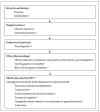Idiopathic Slow Transit Constipation: Pathophysiology, Diagnosis, and Management
- PMID: 38256369
- PMCID: PMC10819559
- DOI: 10.3390/medicina60010108
Idiopathic Slow Transit Constipation: Pathophysiology, Diagnosis, and Management
Abstract
Slow transit constipation (STC) has an estimated prevalence of 2-4% of the general population, and although it is the least prevalent of the chronic constipation phenotypes, it more commonly causes refractory symptoms and is associated with significant psychosocial stress, poor quality of life, and high healthcare costs. This review provides an overview of the pathophysiology, diagnosis, and management options in STC. STC occurs due to colonic dysmotility and is thought to be a neuromuscular disorder of the colon. Several pathophysiologic features have been observed in STC, including reduced contractions on manometry, delayed emptying on transit studies, reduced numbers of interstitial cells of Cajal on histology, and reduced amounts of excitatory neurotransmitters within myenteric plexuses. The underlying aetiology is uncertain, but autoimmune and hormonal mechanisms have been hypothesised. Diagnosing STC may be challenging, and there is substantial overlap with the other clinical constipation phenotypes. Prior to making a diagnosis of STC, other primary constipation phenotypes and secondary causes of constipation need to be ruled out. An assessment of colonic transit time is required for the diagnosis and can be performed by a number of different methods. There are several different management options for constipation, including lifestyle, dietary, pharmacologic, interventional, and surgical. The effectiveness of the available therapies in STC differs from that of the other constipation phenotypes, and prokinetics often make up the mainstay for those who fail standard laxatives. There are few available management options for patients with medically refractory STC, but patients may respond well to surgical intervention. STC is a common condition associated with a significant burden of disease. It can present a clinical challenge, but a structured approach to the diagnosis and management can be of great value to the clinician. There are many therapeutic options available, with some having more benefits than others.
Keywords: colon; constipation; diagnosis; dysmotility; enteric nervous system; management; manometry; pathophysiology; prokinetcs; slow transit constipation.
Conflict of interest statement
The authors declare no conflict of interest.
Figures


Similar articles
-
Constipation: Pathophysiology and Current Therapeutic Approaches.Handb Exp Pharmacol. 2017;239:59-74. doi: 10.1007/164_2016_111. Handb Exp Pharmacol. 2017. PMID: 28185025 Review.
-
[Pathophysiology of slow transit constipation].Zhonghua Wei Chang Wai Ke Za Zhi. 2012 Jul;15(7):758-60. Zhonghua Wei Chang Wai Ke Za Zhi. 2012. PMID: 22851084 Review. Chinese.
-
Slow transit constipation and lower urinary tract dysfunction.J Pediatr Urol. 2015 Dec;11(6):357.e1-5. doi: 10.1016/j.jpurol.2015.05.032. Epub 2015 Jul 29. J Pediatr Urol. 2015. PMID: 26302830
-
Role of Tenascin-X in regulating TGF-β/Smad signaling pathway in pathogenesis of slow transit constipation.World J Gastroenterol. 2020 Feb 21;26(7):717-724. doi: 10.3748/wjg.v26.i7.717. World J Gastroenterol. 2020. PMID: 32116419 Free PMC article.
-
Simultaneous degeneration of myenteric plexuses and pelvic parasympathetic colonic nerve in slow transit constipation: A case report.Medicine (Baltimore). 2017 Mar;96(11):e6390. doi: 10.1097/MD.0000000000006390. Medicine (Baltimore). 2017. PMID: 28296784 Free PMC article.
Cited by
-
Interplay of constipation, intestinal barrier dysfunction and fungal exposome in aetiopathogenesis of Parkinson's disease: hypothesis with supportive data.Biochem J. 2025 Jun 11;482(12):807-21. doi: 10.1042/BCJ20240621. Biochem J. 2025. PMID: 40471586 Free PMC article.
-
Effects of Liqi Tongbian decoction on gut microbiota, SCFAs production, and 5-HT pathway in STC rats with Qi Stagnation Pattern.Front Microbiol. 2024 Mar 15;15:1337078. doi: 10.3389/fmicb.2024.1337078. eCollection 2024. Front Microbiol. 2024. PMID: 38559349 Free PMC article.
-
Poly-γ-glutamic acid alleviates slow transit constipation by regulating aquaporin and gut microbes.Sci Rep. 2025 Mar 10;15(1):8244. doi: 10.1038/s41598-025-92783-2. Sci Rep. 2025. PMID: 40065004 Free PMC article.
-
Protective effects of medicinal plant-derived metabolites on slow transit constipation via the ENS-ICC-SMC pathway.Front Pharmacol. 2025 Jun 11;16:1598806. doi: 10.3389/fphar.2025.1598806. eCollection 2025. Front Pharmacol. 2025. PMID: 40567379 Free PMC article. Review.
References
-
- Peery A.F., Crockett S.D., Barritt A.S., Dellon E.S., Eluri S., Gangarosa L.M., Jensen E.T., Lund J.L., Pasricha S., Runge T., et al. Burden of Gastrointestinal, Liver, and Pancreatic Diseases in the United States. Gastroenterology. 2015;149:1731–1741.e3. doi: 10.1053/j.gastro.2015.08.045. - DOI - PMC - PubMed
Publication types
MeSH terms
LinkOut - more resources
Full Text Sources

